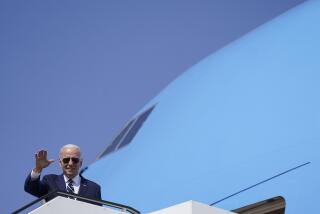Asia’s Future Appears Bright--and That’s Good News for U.S.
- Share via
Traveling through Southern Asia, as I did in late June and early July, one need only keep eyes and ears open to confirm the robust growth, hard work, entrepreneurial drive--and dash of political uncertainty--revolving around China.
Californians are familiar with the achievement of Asian Americans. This is hardly a new story in California.
In Asia itself, however, until quite recently, the success story has been the “Four Dragons”: Hong Kong, Singapore, Taiwan and South Korea. The rapid growth in the last two decades has vaulted these nations’ standards of living from low-income to middle-income.
What is new is the tremendous activity and strong growth throughout major parts of the rest of Asia. Last year, for example, China grew about 10% (much faster in the “free enterprise” south) and Thailand grew 8.6%. The middle-income success stories such as Taiwan and South Korea are now concerned about competing in labor-intensive industries with Malaysia, Vietnam and China, and with seeking, through private decisions and government policy, to move up the value-added chain.
Despite the Clinton Administration’s rhetoric, trade is a positive-sum game. We all benefit when we expand trade. Indeed, every episode of substantial world economic growth has been led by a trade expansion; the converse has been true for world contractions. So while some specific trade frictions will continue to boil up, Asian growth holds great opportunity, as well as challenges, for the American economy.
In a period of generally rising trade, the share of U.S. exports to Asia, excluding Japan, has grown 50% in the last decade, accounting for about one-fifth of our exports. Taiwan, with 21 million people, is one of our half-dozen largest trading partners.
The international trade of Asian economies, excluding Japan, was about $100 billion in the mid-1970s and is now close to $1 trillion, adjusted for inflation. Of this much larger pie, the share going to the industrialized world has declined slightly.
Importantly, intra-Asian trade has blossomed; the share of the much larger volume of international trade of Asian countries other than Japan has grown from 26% to 40%. These countries are still heavily dependent on progress in the industrialized countries, where growth is slowing in the United States, stagnant in Japan and increasingly questionable in the still-young European recovery. But rapid intra-Asian growth provides more of a shock-absorber to these countries than they have had before.
We should applaud the spread of what might be called more formal capitalism to most of Asia. True, China still has a Communist regime, but the explosive growth of southern China probably ensures continuation of the “capitalist experiment.” How rapidly China’s political system will evolve toward more democratic pluralism--and with what bumps along the way--still remains to be seen.
And in addition to the problems that a possible slowdown or recession in the industrialized world would cause the Asian economies, on--or just underneath--the surface in virtually all of these economies is the question of China’s political future.
Hong Kong, for example, is still two years away from formal Chinese takeover, but recent estimates show an influx of half a million Chinese in anticipation of--and in preparation for--that takeover.
Talk to government and business leaders and they tell you that Hong Kong is now implicitly Chinese, not a British colony. Firms that abandoned Hong Kong at the initial agreement for reversion to China and have now returned are finding it harder to do business in Hong Kong, let alone China; those that remained are treated in a more friendly manner.
The South Koreans, of course, are deeply concerned about the military threat, including the nuclear threat, from North Korea. They take little solace from the Clinton Administration’s weak bargain recently with the North Koreans and the failure of the White House to effectively engage the Chinese to pressure the North Koreans.
The Taiwanese, finally, are working to expand interaction with mainland China. The succession struggle in Beijing makes it imperative for any would-be leader to be “tough on Taiwan.”
With the recent visit of Taiwan’s President Lee Teng-hui to Cornell University and some other events, the mainland Chinese are certainly talking tough. As usual, some deft diplomacy and time are the best cures for this temporary flare-up in rhetoric and pressure from Beijing.
Barring a destabilized China--a possibility I consider unlikely, but not quite remote--Asia’s future looks bright. There may well be a slowdown or recession in the next few years.
But long-run growth prospects are strong, given the tremendous returns these economies are likely to reap from capital investment raising the productivity of their workers over the next several decades.
Japan is another story, but one for another time.
More to Read
Inside the business of entertainment
The Wide Shot brings you news, analysis and insights on everything from streaming wars to production — and what it all means for the future.
You may occasionally receive promotional content from the Los Angeles Times.









